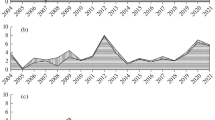Abstract
In the years 1976–1981 the density of mice and voles was estimated by snaptrapping in 65 cultivations in different woodland areas in Bavaria. The trapping procedure was repeated at the same places after 3 and 6 months. All the trapped specimens were frozen in the field and later dissected in the lab. 21 different parameters of population structure and of morpho-physiological condition of the animals were compared with the development of the density of each species in the different areas. All together 1447 redbacked voles (Clethrionomys glareolus), 869 common voles (Microtus agrestis) and 873 yellownecked field mice (Apodemus flavicollis) were taken into the analysis. It was observed that the fertility resp. the weight of testes was significantly correlated with the change of density of all three species. In all cases also the percentage of pregnant females and the percentage of embryoes related to the total number of trapped specimens, was positively correlated with the development of density. It is suggested that these correlations can help to forecast the development of population density of mice and voles in forest plantations.
Similar content being viewed by others
Literaturverzeichnis
Bäumler, W., 1973: Über einen Zusammenbruch der Gelbhalsmauspopulation im Nationalpark Bayerischer Wald. Anz. Schädlingskde., Pflanzenschutz, Umweltschutz6, 161–168.
Bäumler, W., 1979a: Über den Einfluß von Witterungsfaktoren auf das Wachstum markierter Erdmäuse (Microtus agrestis L.). Anz. Schädlingskde., Pflanzenschutz, Umweltschutz52, 4–10.
Bäumler, W., 1979b: Die Sommerkrise der Erdmaus (Microtus agrestis L.) Teil I. Die Entwicklung einer freilebenden Population. Anz. Schädlingskde., Pflanzenschutz, Umweltschutz52, 65–70.
Bäumler, W., 1980: Die Sommerkrise der Erdmaus (Microtus agrestis L.) Teil II. Aufzucht in der Gefangenschaft. Anz. Schädlingskde., Pflanzenschutz, Umweltschutz53, 177–181.
Bäumler, W., 1981: Zur Verbreitung, Ernährung und Populationsdynamik der Rötelmaus (Clethrionomys glareolus) und der Gelbhalsmaus (Apodemus flavicollis) in einem Waldgebiet der Bayerischen Alpen. Anz. Schädlingskde., Pflanzenschutz, Umweltschutz54, 49–53.
Birney, E. C., Grant, W. E., Baird, D. D., 1976: Importance of vegetative cover to cycles of microrus populations. Ecology57, 1043–1051.
Clarke, J. R., 1977: Long and short term changes in gonadal activity of field voles and bank voles. Oikos29, 457–468.
Dakatse, M. J., Martinet, L., 1977: Effect of temperature on the growth and fertility of the field vole,Microtus arvalis, raised in different daylength and feeding conditions. Ann. Biol. Anim. Bioch. Biophys.17, 713–721.
Delost, P., 1975: Un modele de l'influence du facteur nutrition dans la reproduction des Mammiferes: Le cycle sexuel saisonnier du Campagnol des champs. Extrait Bull. Soc. Zool. France100, 42–66.
Frank, F., 1954: Untersuchungen über den Zusammenbruch von Feldmausplagen (Microtus arvalis Pallas). Zool. Jb., Syst.82, 95–136.
Heikura, K., 1977: Effects of climatic factors on the field voleMicrotus agrestis. Oikos29, 607–616.
Herold, W., 1954: Beobachtungen über den Witterungseinfluß auf den Massenwechsel der Feldmaus. Zeitschr. Säugetierkde.19, 86–107.
Klemm, M., 1960: Beitrag zur Prognose des Auftretens der großen Wühlmaus (Arvicola terrestris L.) in Deutschland. Zeitschr. angew. Zoologie47, 129–58.
Krampitz, H. E. undBäumler, W., 1978: Vorkommen, Saisondynamik und Wirtskreis vonBabesia microti (Franca, 1912) in einheimischen Nagetieren. Z. Parasitenkde.58, 15–33.
Maerks, H., 1954: Über den Einfluß der Witterung auf den Massenwechsel der Feldmäuse (Microtus arvalis Pall.) in der Wesermarsch. Nachrbl. dtsch. Pflanzenschutzdienst6, 101–118.
Marsh, M. P., 1962: Food as a factor regulating the numbers of the california vole (Microtus californicus). Ph. D. dissertation Unif. Calif., Berkeley, 201 pp.
Myllymäki, A., 1976: Outbreaks and damage by the field vole,Microtus agrestis, since the World War II in Europe. Joint FAO/WHO/EPPO conference on rodents of agricultural and public health concern, Geneva, Switzerland, June 1976.
Niemeyer, H., 1979: Beobachtungen zum Massenwechsel der Erdmaus (Microtus agrestis) und der Rötelmaus (Clethrionomys glareolus) in Niedersachsen und zur Möglichkeit einer Prognose. Aus dem Walde31, 233.
Polyakov, I. J., 1959: Forecasting of rodent populations. Report of the int. conf. of harmful mammals and their control, pp. 39–47, Paris.
Schindler, U., 1959: Zur Erdmausprognose. Anz. für Schädlingskde.32, 101–106.
Stenseth, N. C., 1977: Modelling the population dynamics ol voles: models as research tools. Oikos29, 449–456.
Straka, F., Gerasimov, S. 1971: Correlations between some climatic factors and the abundance ofMicrotus arvalis in Bulgaria. Ann. Zool. Fennici8, 113–116.
Author information
Authors and Affiliations
Additional information
Mit 2 Abbildungen und einer Tabelle
Rights and permissions
About this article
Cite this article
Bäumler, W. Ein Beitrag zur Prognose der Populationsentwicklung von Mäusen in Forstkulturen. Anz. Schadlingskde., Pflanzenschutz, Umweltschutz 55, 40–44 (1982). https://doi.org/10.1007/BF01906661
Issue Date:
DOI: https://doi.org/10.1007/BF01906661




